Notre Dame losing by 11 points at Ohio State wasn’t a total surprise, but the advanced stats from this game would have qualified as a shocker for fans before the game. Breaking down how the Irish stayed close with a draw in explosive plays, ultimately couldn’t hang with the Buckeyes because of a dramatic loss in rushing efficiency, and couldn’t find the few extra edges needed for the upset.
Stats from a few excellent sources – College Football Data, Game On Paper, and often referencing SP+ and FEI numbers. If you get lost, check out this handy advanced stats glossary here or reach out in the comments.
The Irish battled and had things looking very even until losing both lines of scrimmage caught up with them
Notre Dame entered with a sound underdog gameplan, intent on limiting possessions against a Buckeye offense hyped as one of the best in the country. There was hope the Irish might have advantages in both trenches against an OSU team that struggled physically in last season’s two losses. Ohio State decisively won both line battles, but with a terrific defensive effort and a few breaks (Jaxon Smith-Njigba out, CJ Stroud not his sharpest, an incredible Matt Salerno catch), the tantalizing upset was still in reach late into the fourth quarter.
The ND offense hardly had the ball in the second half (just 20 total plays!) but hit a late wall with Tyler Buchner under consistent pressure and the initial run-heavy approach floundering. In some ways, the Irish’s surprising defensive success may have made the right level of offensive aggression more confusing. In a tight game where just one more break or explosive play might win, how much do you force the issue while ahead or still within a score? The Buckeye rushing attack let them pull away with two late touchdowns, but even on those drives, the Irish scheme was fairly successful, forcing third downs where unfortunately CJ Stroud made a few exceptional plays to shut the door.
Notre Dame technically won the explosiveness battle, but both defenses clamped down
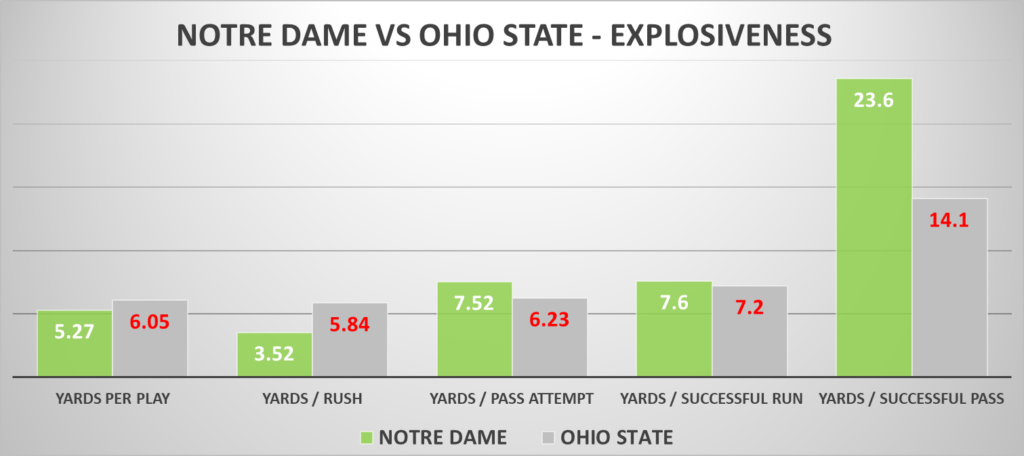
Let’s start by giving the defense their flowers, with the telecast was reluctant to do! (This may have put me over the edge on #TeamMute, as getting stops at a loaded offense was continually described instead as “making Ohio State be patient”). It was a terrific performance in Al Golden’s debut, holding the Buckeyes around six yards per play and per pass attempt. This was an offense with Stroud that averaged nearly ten yards per attempt last year, including over eight yards per attempt in both losses. It wasn’t Stroud’s best performance, and Smith-Njigba’s absence was a huge boost, but the narrative shift from this being the deepest and most talented receiving room in the nation to one that couldn’t be expected to do much without their star gave me whiplash.
The secondary was particularly outstanding, with just a few hiccups in a pressure-packed game against a loaded skill position group. There were no breakdowns in communication despite the lack of game reps together with a transfer starting at safety and two true freshmen playing significant snaps at corner. Tackling was terrific keeping Ohio State receivers short of the chains after third-down catches. The presumed weak point of the defense showed out and forced Stroud to make throws into tight windows to beat them.
Is the performance against the run cause for concern? I’d argue it’s far too early for that. The Buckeye offensive line was extremely impressive and is a virtual lock to be the best Notre Dame faces this year. Schematically the Irish gave OSU fairly light boxes most of the night, ensuring they were covering the pass and not getting beat deep. More havoc would have been welcomed, and the Notre Dame pass rush disappointed as a whole. But I wouldn’t change expectations of this being a top-20 defense against the run based on this opening challenge.
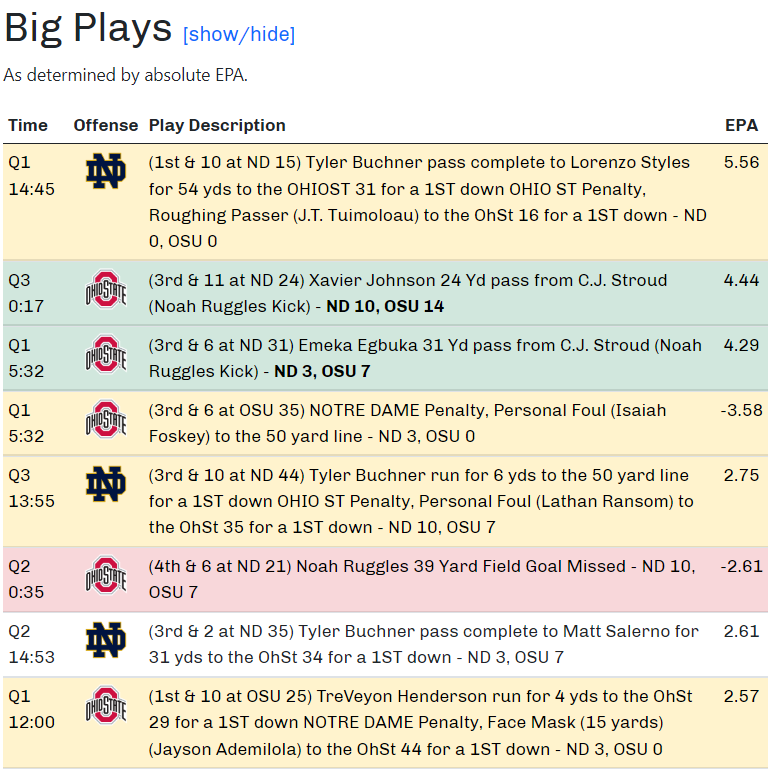
It was a massive win for the Irish to hang with Ohio State in explosive plays, with Buchner able to give Lorenzo Styles, Matt Salerno, Michael Mayer, and Braden Lenzy shots to make something happen. A draw in explosive play rate was ideal, but the lack of big plays on either side meant that Ohio State’s ability to sustain drives separated them from Notre Dame’s struggling offense. Buchner’s downfield throws and general poise were encouraging, and he was on target with his easier-designed throws when on time (quick RPOs, screens).
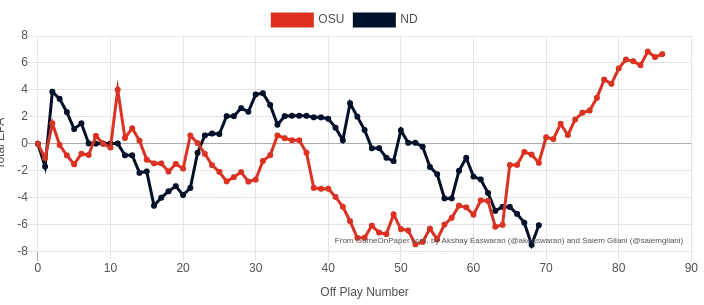
But the line struggled to communicate against Jim Knowles’s pressures and holding blocks, and Buchner rarely had much time to survey the field. When he did, it seemed like Tommy Rees had engineered some very easy reads – early on these were effective and seemed to settle the first-time starter down, but later it felt like too much conservatism with it clear the passing game was going to be the engine to drive further scoring. The running game was just successful enough (and the game remained close enough) that Rees didn’t abandon it, and to his credit, when the Irish had their best field position, Rees was more aggressive downfield. But similar to early in the 2021 season, the Irish offensive line struggles doomed any hope of long sustained drives – it was going to take chunk plays to create scoring opportunities, and Notre Dame couldn’t create them late.
With few big plays or turnovers, the game swung on Ohio State’s huge edge being able to run efficiently
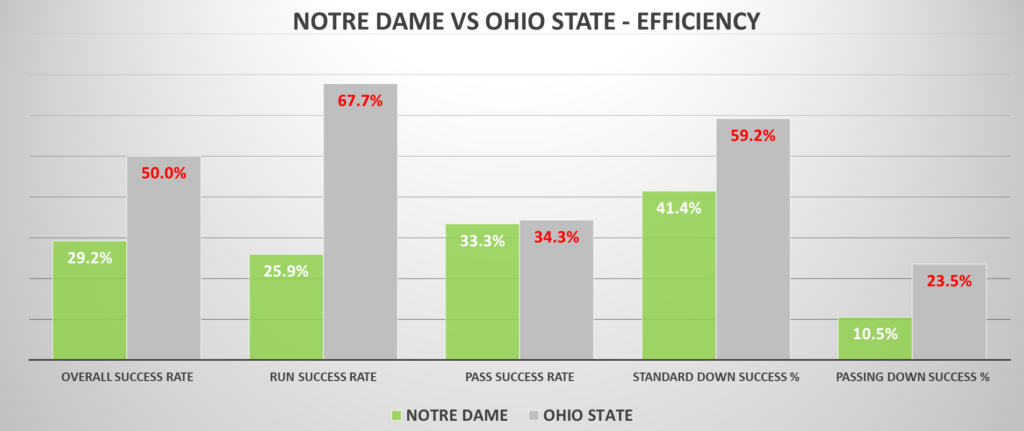
If I had seen this chart before the game, I might not have watched and would have been shocked to see the final score as close as it ended. To be fair, the success rate battle looked completely different in the first half, with Notre Dame at 40% and Ohio State at 33%. Both defenses were excellent on passing downs, but unsurprisingly Buchner struggled even more than Stroud in these situations and faced more of them (4o% of ND plays vs 26% of Ohio State).
This is where the offensive line let the gameplan down – the Irish ran on 2/3 of early downs, but these attempts averaged 3.5 yards per play, and just 7/23 were successful. Third and long plays summed up the offensive performance and gameplan – the Irish faced eight plays of 3rd and 8 or longer, and converted just one thanks to an unnecessary roughness penalty.
There weren’t enough plays or enough successes for any individual ND player to stand out with their efficiency. It was dreary across the board, but Buchner’s rushing numbers stand out because you’d expect them to be one of the offense’s best shots between designed runs and scrambles. But the sophomore was successful on just one of eight rush attempts. Eight targets to Mayer were barely better, with just two successful plays. The top Irish players by total EPA produced were Styles and Salerno, with one important catch each.
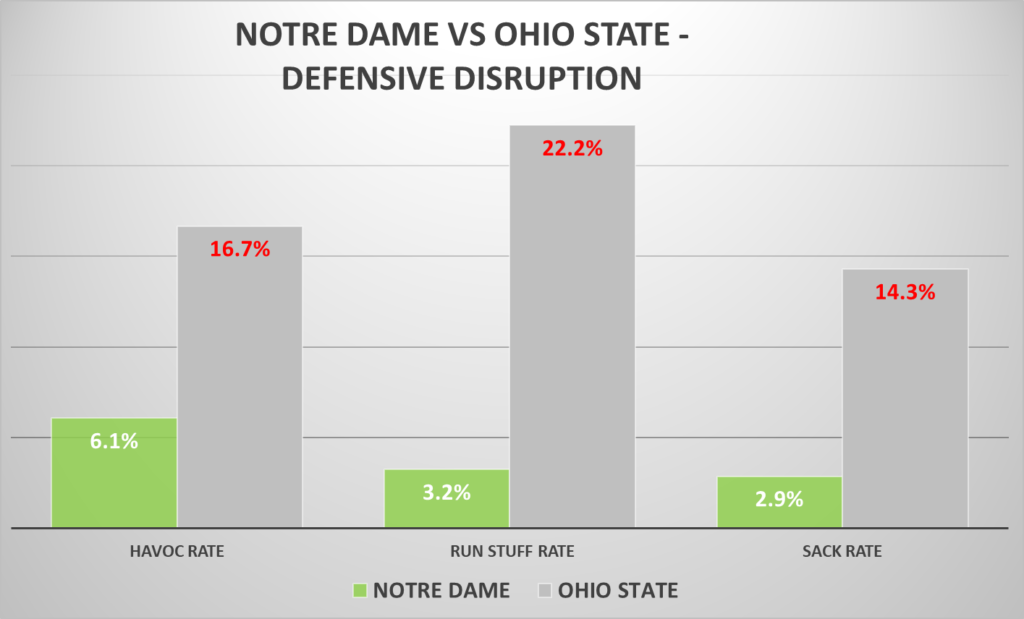
While the defense shined overall, it’s hard to win without disrupting the Ohio State offense a bit more. For the game the Irish defense had just four havoc plays on 66 OSU snaps – one sack, one TFL by Bracy on Smith-Njigba, and two pass break-ups. Ohio State was just far more productive on their “unsuccessful plays” that weren’t incompletions to keep things more manageable. Meanwhile, the Buckeye defense created a solid rate of negative plays that threw Buchner into the passing downs where the Irish offense struggled.
If Notre Dame wasn’t going to win in the trenches, the upset would have required more breaks finishing drives, forcing turnovers, and finding some field position edges
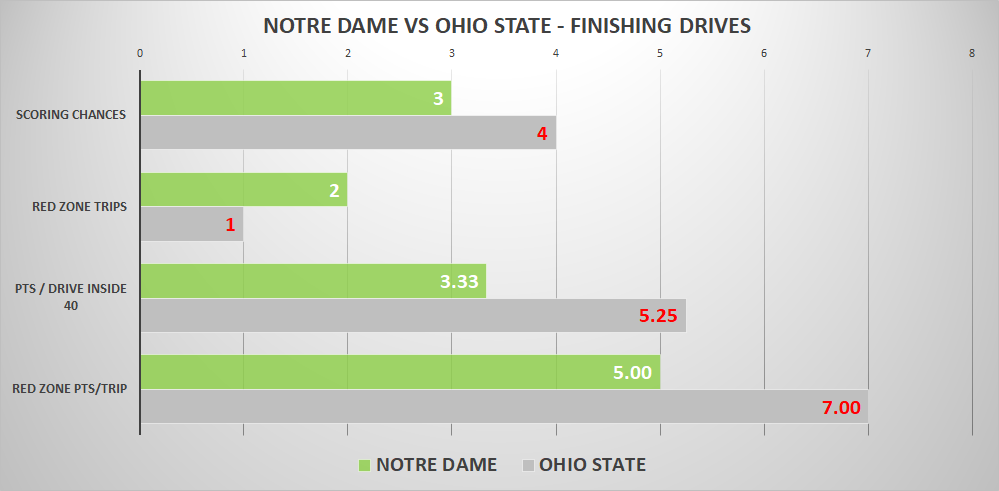
Notre Dame kept the scoring opportunities close, but in hindsight probably would like to have a few of those missed chances back. A quick breakdown of the key decisions:
- After the massive Styles reception with a personal foul tacked on, the Irish were immediately in the red zone to start the game. Runs on first and second down went a total of one yard, and on third down a Buchner designed run (maybe with a pass option built in?) never came close to looking like a conversion. Somewhat understandable that the staff wanted to ensure the Irish drew blood, but indicative of the overall lack of aggression and faith shown in Buchner.
- Early in the 3rd quarter with the lead, the Irish had their best field position of the game at their own 44. This time they went for it – Buchner’s 1st down pass to Styles downfield was just off, a 2nd down pass was batted down, then Notre Dame got a gift with a late hit on Buchner’s 3rd down scramble. With a scoring chance the next two runs went nowhere, and on 3rd and long a somewhat dangerous throw to Lenzy in coverage was incomplete.
- Starting the 4th with momentum after the long completion to Lenzy, the Salerno OPI put Notre Dame in a tough spot. But a Buchner run, then Tyree run on 2nd and 18, and finally another Buchner QB draw on 3rd and 18 was an extremely tough sequence.
The incredibly quiet special teams and turnover categories played a significant role in the low-scoring game. Again, a category that if the Irish could have grabbed a break or two, maybe this is coming down to a final drive as time expires. But neither team created many opportunities for a takeaway – zero forced fumbles (only the Mayer drop while dodging) and only two pass break-ups by each defense. Notre Dame’s average starting field position was their own 18, another recipe for disaster with some notably bad efforts in the kick return game.
On to Marshall
It’s time for the annual reminder about how little we still know about this team. Openers can generally be weird and clunky, and starting the year against a team as talented as Ohio State makes the interpretation even more difficult. Recent seasons give us good reminders not to write any of these conclusions in pen – remember the linebacking struggles at Louisville in 2019 that were quickly followed by excellence against UGA in Athens? Or the 2020 team that averaged less than five yards per carry and poor run efficiency against Duke, then won the Joe Moore award with a fairly dominant run game?
What parts of this performance were indicators of how good the talented Buckeyes team is versus where Notre Dame has real issues? We won’t know for some time. But I’d wager that Ohio State’s defense is pretty real with Jim Knowles upgrading the brainpower, many terrific pieces from last year returning (including safeties whose names I don’t remember hearing much Saturday), and a bunch of young top-50 recruits coming into their own.
If anything, this team exits Columbus in mostly the same state it arrived. Confidence in some individual players or units might be in flux, but this is a team that appears firmly in the blob behind the most talented teams in the sport (again). Can Marcus Freeman help wring the most out of the roster, developing key players and putting them in the right places to end up toward the top of that second tier?



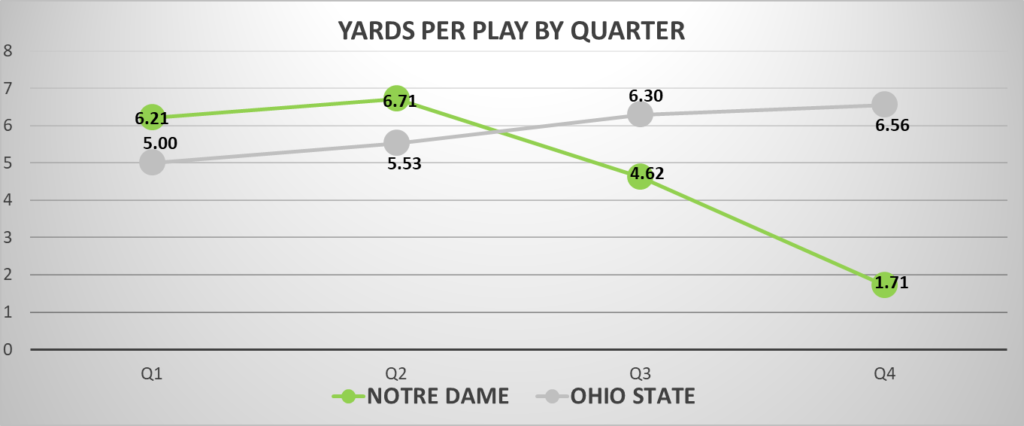



That Salerno catch was really crazy
Jermaine Kearse in the super bowl esque
I thought this was a forced fumble, pretty sure an tOSU player got a hand on the ball.
Hmm haven’t re-watched to take a look but if it was, the official stats missed it, no credit given to a player for a forced fumble
The OSU player definitely knocked it and changed how it was laying in his grip, but Mayer only dropped it when he went to reposition it. I’d score it a forced fumble too.
It didn’t look like it to me. I saw Mayer bounce the ball off a pad as he was trying to switch hands.
The question for me is if this was our best chance to beat them this year, i.e. Do we improve enough over the course of the year that we can play them closer or win in a playoff game? Do they improve that much over the course of the year?
Overall, I think we did good. No one expected Buchner to light it up on his first game as a starter (would have been nice) and he remained poised under pressure. Our defense played extremely well through three quarters and got gassed in the 4th due in part to our offensive inefficiency.
USC looked much better on their first game out than I was expecting… Our game with them went up a notch or two on my worry meter. UNC and BYU offenses looked quite potent, BYU’s defense has improved over last year I think. Those games I still mentally have as ND wins. I am glad college football is back.
The first question is near-impossible, JSN is a big big deal in this, but so is Patterson. Unfortunately the smart money is probably on OSU to improve more, just by virtue of having a deeper + more talented roster. They could run into some issues at current strengths that arent super deep like OL, but same is true for ND, would need all the breaks to go our way.
I thought about doing a quick opponent stock watch, I think SC + UNC are pretty neutral. Massive for Mack that Drake Maye looks awesome, but the defense looking so bad still is almost equally concerning. SC I just cant take anything away from that performance, Rice is bad bad and we need to see the defense play someone real (which wont happen this week, sorry Stanford!),
Syracuse was the one that caught my eye, their defense did a really nice job against Louisville and the offense looks really good with Anai (UVA’s OC last year). Their passing game was awful but if they can be multidimensional with Tucker they have some real juice.
In case people are still undecided about how excited to be about the defense’s performance against the pass on sat – see this article by friend of the site Jamie U: https://irishsportsdaily.com/s/18694/film-dont-lie-notre-dames-dialled-in-defense-vs-cj-stroud
That’s a good share. And it’s not like we were getting pressure with four and dropping seven during this game, so maybe things can even improve once we start facing worse offensive lines.
The lightbulb fully coming on for Bracy would be nice. If so, all of a sudden we have legit CB depth.
Good point about the lack of pressure so it’s not like we were making it especially easy for our secondary.
When was the last time we felt good playing 5(!!!) corners?
I’m actually pretty hopeful that OSU’s OL is pretty darn good and that our D will be elite this year. I’d be willing to bet that 21 will be their lowest scoring game of the year – including playoffs – maybe even by a wide margin. And it’s hard to imagine anyone other than USC coming close to the firepower OSU has on offense.
I’m even hopeful that OSU’s DL has some elite talent coupled with Knowles really confusing our OL (esp. without Patterson) that our offense will pick it up when our OL plays better.
I embrace those hopes! I felt bad after that loss, I am sick of losing to the B-eyes. But yes, good chances to grow.
Knowles claims they played a pretty vanilla scheme against us. As long as Josh Lugg is starting for us, I’m going to be extremely worried against any D Line with even a bit of talent. Hopefully Spindler or somebody has stepped up by the time we get to Clemson.
Buchner wasn’t the reason we lost the game, but the lack of faith in him was the reason we couldn’t win it either. They seemed to be daring him to take shots to the middle of the field, and we did that once. Our offense seemed a bit like a rope a dope, except that when it came time to take the big shot, we ran a QB draw on 3rd and 18.
Our WR room is awful. It has been for years. Perhaps Styles would be in the rotation at FSU (can’t make a decision on Colzie, Meriweather since they didn’t play). All of their receivers would start for us. The talent gap is that large. Unless they are schemed open to a spot in a zone, they don’t win man battles.
Alt/Kristofic were fine on the left side. I thought Correll did ok. For his third start, Fisher was fine. It struck me that nearly all of the problems on run and pass blocking involved Correll/Lugg, Lugg or Lugg/Fisher. When Patterson comes back, if he goes to LG, Kristofic needs to slide over. If Lugg is really one of our top 5 OL, it doesn’t speak well of Spindler or Kristofic. However, I will concede I am not an expert on evaluating line play.
Since he’s been OC, Tommy has barely called any play action passes or shots to the middle of the field. It’s mind boggling.
But all the advanced stats say that play action is useless…
https://weeklyspiral.com/2021/10/29/play-action-passing-is-the-best-play-in-football/
There were a couple calls I hated but I think a lot of the piling on Tommy is overblown. A lot of the play-action they ran ended with a guy in Buchner’s face once he carried out the fake, which doesn’t exactly open up the throw down the seam. The 3rd + 18 draw I’m fairly confident was with intent to gain 6-10 and go for it on 4th.
The WR room is a major problem, I don’t think those guys are bad or can’t win one on one, they just all are having to play outsized roles because the massive holes in upperclassmen.
By my, admittedly inaccurate count, there were at most three targets to Lenzy, two targets to Styles, 1 to Thomas (nowhere actually near him), and three to Salerno. We have to assume you run routes and make decisions to get the ball to your best players. That distribution tells me we think Salerno is one of our top 2 receivers. Frightening. I am hoping that is a one game anomaly, and will hopefully change when Wilkins, Colzie and Merriweather are healthy again. Other than the quick hitter to Styles to open the game, were any of the receivers really even open? They just don’t get separation.
This has now gone through three QBs (Book, Coan, Buchner) and is a problem. We all said Book had ‘happy feet’ and took off too soon or didn’t throw receivers open. Maybe the WRs were not open, and he knew they wouldn’t be. For Coan, it was held the ball too long and didn’t throw receivers open. Maybe he was holding the ball and hoping. A little early to decide where Buchner falls, we really won’t know how they treat Buchner until after the BYU game, but the issue doesn’t seem to be the QB. I think it lies in the WR room and the play calling. Buchner should be a near-elite QB based on his ranking, but with subpar receivers, even a Moore or a Carr or a Manning will look mediocre.
This is also the first year in a long time where we don’t have an obvious dominant senior WR. Austin became that. Claypool and Boykin before that. As much as I like Meyer, we need the top receiver to be a WR not a TE. He can open the middle of the field, and hide the lack of depth at WR by essentially being the ‘slot’ guy, but sending him wide negates his size advantage and accentuates his one weakness, lack of elite speed. Not that a TE should have elite speed, but any and every CB in America can run with him. So every pass will have to be high and then he will have to break at least one tackle.
The penalty on Salerno altered the play-calling and may have kept us out of a red zone trip. With the offense struggling and in a hole to get the first down, did that affect the Advanced stats at all or significantly?